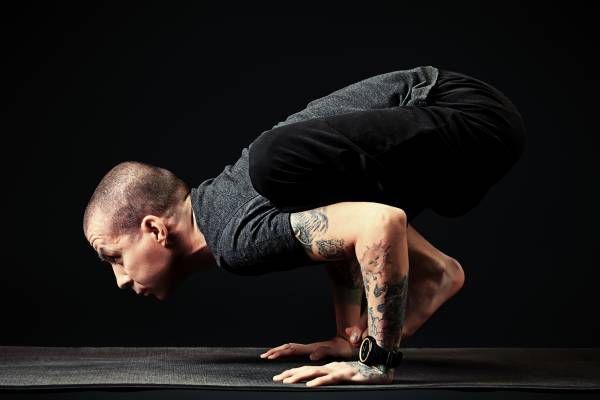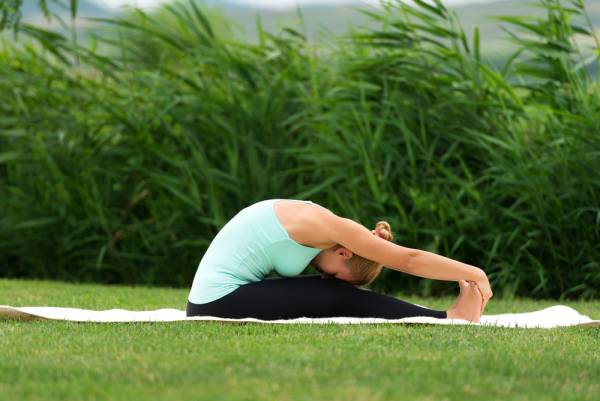Recently this rather intriguing question came in from a reader:
I’m a female bull rider looking to tweak my training routine. I’ve been lifting for a couple of years, but getting into bull riding now I know I need to focus more on a combination of bodyweight strength and flexibility (yoga type stuff). Can you give me an idea of how I should program my training for maximum relative strength, and explosive flexibility? I’m 5’4 at 135 pounds and roughly 18% body fat. I can do 5 strict chin-ups, 15 pushups, hold a handstand for over a minute – nothing crazy, but a good foundation. How do I work progressing to one arm push ups/pull ups, handstand pushups, front levers etc. into a routine?
Well, that’s one I hadn’t heard before! But while this question catches the eye with its uniqueness, the issues it addresses are far more universal – and often ignored.
Breaking the Question Down
There are two questions involved in this reader’s email:
- How to build combined bodyweight strength and flexibility
- How to work more advanced bodyweight exercises into your routine
The answer to the second is about time and practice. As you build strength, you can move toward modifications of more advanced exercises, eventually evolving them to their full realization. Try using a wall to help with stabilization, or find a workout buddy and spot each other as you move forward. Be careful, be patient, and have fun.
The first question, on building combined bodyweight strength and flexibility, invites more discussion. There’s a series of thoughts in the reader’s question, all heading in the right direction, but not quite reaching their logical conclusion. “Training for maximum relative strength and explosive flexibility” and doing “yoga type stuff” are in the realm of a concept that many tend to have selective hearing about in the strength-training world – adaptability.
Adaptability Versus Strength
Adaptability and strength are not necessarily the same. The fact that our bull rider friend is asking this question indicates she’s well aware of this fact. We like to think that if we bulk up our muscles we’ll be strong enough for any task, but that’s not necessarily true. For optimum performance in athletic activities, as well as day-to-day living, we need functional strength. Strength that integrates our muscles while maintaining mobility allows us to adapt to situations as they come, leading to optimum performance under changing conditions.
Bull riding is almost too perfect an example of this. When you’re being thrown every which way, with minimal predictability, your main goal is being able to adapt to the rapidly changing conditions. Our questioner has the right idea in using bodyweight exercises to train for this kind of adaptability. Because bodyweight exercises demand the body to work as an integrated whole, rather than breaking it into isolated parts, they train it to be strong in a functional, adaptable way.
“The idea of using ‘yoga type stuff’ to train for adaptability is spot on. Yoga is all about adaptability, mentally and physically.”
When it comes to training for adaptability, though, not all bodyweight exercises are created equal. The idea of using “yoga type stuff” to train for adaptability is spot on. Yoga is all about adaptability, mentally and physically. The following yoga-inspired guidelines can help you develop a training program to enhance functional strength and adaptability, so you can take on whatever life throws at you (or, in the case of our bull riding friend, whatever way you find yourself thrown).

1. Choose Integration Over Isolation
One area where yoga practice excels is in integrative strength training. Isolating muscles in split training programs is a popular strength-training method, and with good reason. It allows you to absolutely fatigue muscle groups, knowing they’ll have time to recover the next day. There is a major downside to this, though. Isolating muscles often means they don’t learn how to work together, leading to astounding strength in individual muscles, but a lack of functional, full-body strength.
Strength training for adaptability means training the body to work together as the well-oiled machine it is so beautifully built to be. Cohesive, integrated muscle movement creates functional strength. One 2013 study published in the Journal of Strength and Condition Research suggested that integrated training may provide a larger increase in performance than isolated strength training. This is because “activities of daily living, as well as recreation and sport, involve a combination of attributes including strength, speed, balance, and coordination through multiple planes.” Isolation exercise doesn’t offer these benefits. Integrated training does.
“You can reap the benefits of this integrated strength training through bodyweight exercises that require the whole body to work as a whole.”
Integration exercises have also been shown to be key to increasing core strength, which is vital to improving stability, reducing injury, and maintaining mobility. In one recent study, integration core exercises resulted in greater core activation than isolation exercises.
You can reap the benefits of this integrated strength training through bodyweight exercises that require the whole body to work as a whole. Variations on planks and push ups, inversions such handstands or headstands, and yoga-style arm balances are all great places to start. Anything that challenges balance, such as one-armed push ups or pistol squats, will also have a similar effect.
2. Stretch and Strengthen at the Same Time
When we’re discussing adaptability, it’s better to think of flexibility as “mobility” and strength as “stability.” While maximum performance means cultivating both, it also means keeping the two in balance. Too much mobility without any stability is a recipe for disaster. To picture this, imagine a toddler stumbling about. She has enviable mobility, touching her toes or putting her legs behind her head like its nothing. But she tends to tumble and fall all over herself, displaying a notable lack of stability.
Too much stability with little mobility is the other extreme. It’s one you may be more familiar with in your own body, especially if you frequently weight train. Those who are extremely muscular, but have neglected mobility training tend to get tight muscles and ligaments. They are extremely stable, but if they come under stress in the wrong direction, they tend to break rather than bend.
“A 1991 study of female collegiate athletes across eight weight-bearing sports showed that those with strength and flexibility imbalances were more prone to injury.”
Balance between mobility and stability (flexibility and strength), then, is key, both for adaptability and injury prevention. In fact, you could say adaptability is injury prevention. The ability to respond to changing conditions means the body can accommodate stress, rather than strain under it. Science backs this up. A 1991 study of female collegiate athletes across eight weight-bearing sports showed that those with strength and flexibility imbalances were more prone to injury.
Yoga practitioners consciously cultivate this balance by bringing strength and flexibility together. They deliberately support flexibility exercises with strength and imbue strength-based movements with flexibility. You can find this same sense of balance through intentional, concentrated stretching, and mobility training.

Try this basic hamstring stretch as an example:
- Sitting on the floor with your legs extended, reach forward to try to touch your toes.
- Make sure your pelvis isn’t tilted backward, keeping your spine long and extended from your tailbone through your neck. Sitting on the edge of a folded towel can help with this. If necessary, bend your knees.
- Exhale to engage your lower abdominals, finding support as you pull the navel toward the spine.
- Inhale to fill the rib cage, scooping the navel forward and up to draw you further into the stretch.
- Notice how this almost-isometric contraction brings a strength element into this common flexibility exercise.
3. Train Your Brain
Adaptability is mental as well as physical. Take a hint from the yogis, and bring some mindfulness into your bodyweight workout. The result will be a calmer, steadier mind that deals better with stresses and stimuli – including careening about on a bull.
While it may seem like pure hippie stuff, mindfulness practice is getting a lot of attention in the always-skeptical scientific community. Your brain can be trained just like a muscle. An article published in the May 2012 issue of the Medical Hypotheses Journal postulated that yoga practices help increase vagal tone. The vagus nerve is the largest cranial nerve in the body, and is responsible for regulating major bodily functions, including breath, heart rate, and digestion. It also determines our ability to process our experiences, helping us manage whatever life throws at us.
“Try pairing your movements with long, even inhales and exhales. Move slowly and consciously, placing all of your attention on the task at hand, rather than letting your mind wander.”
Low vagal tone leads to poor digestion, increased heart rate, and messy moods. It’s associated with depression, post-traumatic stress disorder, and chronic pain. Yoga has been shown to improve all these conditions. It pays to exercise your brain.
You don’t need to sign up for a yoga class to tone up your vagus, though. Bringing the yogic mindset into your bodyweight training can work wonders. It’s a simple as drawing your attention to your breath, keeping it calm, slow, and steady as you work. Try pairing your movements with long, even inhales and exhales. Move slowly and consciously, placing all of your attention on the task at hand, rather than letting your mind wander.
Don’t Get Thrown
Adaptability is worth the effort. Build your program with these guidelines and avoid getting thrown, whether you’re riding a bull or just moving through life.
Finally, to our bull-riding hero: Good luck! Hope this helps!
More Like This:
- Understanding and Analyzing Your Movement Environment
- Don’t Be a Specialist: Your Routine Needs Variety
- Create Muscular Balance With Unilateral Training
- New on Pulse Beat Fit Today
References:
1.DiCarrado, Stefanie. “Research Review: Effects of Integrated vs Isolated Training on Performance and Neuromuscular Control.” Brent Brookbush. 2014. Accessed September 1, 2015.
2. DiStefano, L., DiStefano, M., Frank, B., Clark, M., and Padua, D. “Comparison of integrated and isolated training on performance measures and neuromuscular control.” Journal of Strength and Conditioning Research/National Strength & Conditioning Association 27, no. 4 (2013): 1083-1090.
3. Knapik, JJ, CL Bauman, BH Jones, JM Harris, and L. Vaughan. “Preseason Strength and Flexibility Imbalances Associated with Athletic Injuries in Female Collegiate Athletes.” American Journal of Sports Medicine 19, no. 1 (1991): 76-81. Accessed September 1, 2015.
4. Streeter, C.C., P.l. Gerbarg, R.B. Saper, D.A. Ciraulo, and R.P. Brown. “Effects of Yoga on the Autonomic Nervous System, Gamma-aminobutyric-acid, and Allostasis in Epilepsy, Depression, and Post-traumatic Stress Disorder.” Medical Hypotheses 78, no. 5 (2012): 571-79. Accessed September 1, 2015.
5. Wilson, Angela. “Scientific Research: How Yoga Works.” Yoga International. October 9, 2014. Accessed September 1, 2015.
6. Wortman, Joshua. “Science Says “Integration” Exercises Activate Muscle More Than Isolation Exercises.” Pulse Beat Fit. Accessed September 1, 2015.
Photos courtesy of Shutterstock.






